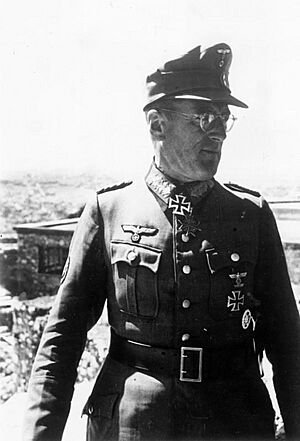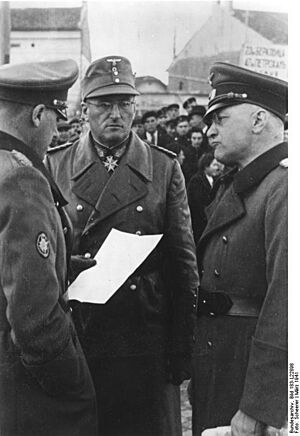Ferdinand Schörner facts for kids
Quick facts for kids
Ferdinand Schörner
|
|
|---|---|

Schörner in 1941
|
|
| Commander-in-Chief of the German Army | |
| In office 30 April 1945 – 8 May 1945 |
|
| Preceded by | Adolf Hitler |
| Succeeded by | Office abolished |
| Personal details | |
| Born | 12 June 1892 Munich, Kingdom of Bavaria, German Empire |
| Died | 2 July 1973 (aged 81) Munich, West Germany |
| Political party | Nazi Party |
| Civilian awards | Golden Party Badge of the NSDAP |
| Signature |  |
| Nicknames | Blutiger Ferdinand (Bloody Ferdinand) Ungeheuer in Uniform (Monster in uniform) |
| Military service | |
| Allegiance | |
| Branch/service | |
| Years of service | 1911–1945 |
| Rank | Generalfeldmarschall |
| Commands | Army Group South Army Group North Army Group Centre |
| Battles/wars |
See battles
|
| Military awards | Pour le Mérite Knight's Cross of the Iron Cross with Oak Leaves, Swords and Diamonds |
Ferdinand Schörner (born June 12, 1892 – died July 2, 1973) was a German military leader. He reached the high rank of Field Marshal in the German army during World War II. He led several large groups of soldiers called army groups. He was also the very last Commander-in-Chief of the German Army.
Schörner was a strong supporter of the Nazi Party. He was known for being very strict and tough. By the end of World War II, he was a favorite commander of Adolf Hitler. After the war, he faced legal charges for his actions. He was held in prison in the Soviet Union and Germany.
Contents
Early Life and Military Start

Ferdinand Schörner was born in Munich, Germany, on June 12, 1892. In 1911, he joined the Bavarian Army. By 1914, he was a lieutenant. He fought in World War I. He received a special military award called the Pour le Mérite. This was for his bravery in the Battle of Caporetto in 1917.
Between World War I and World War II, Schörner continued his military career. He worked as an officer and a teacher. In 1923, he helped stop a political uprising in Munich.
Role in World War II
Schörner led the 98th Mountain Regiment during the invasion of Poland in 1939. In 1941, he commanded the German 6th Mountain Division. He earned another award, the Knight's Cross, for breaking through the Metaxas Line in Greece. His division then took part in Operation Barbarossa in June 1941. This was the German invasion of the Soviet Union.
His division was sent to the Arctic areas of the Eastern Front. In 1942, he became a general and took command of the XIX Mountain Corps in Finland. His job was to protect important nickel mines. He also fought in a failed attack on the city of Murmansk.
Later, from 1943 to 1944, he led the XXXX Panzer Corps on the Eastern Front. In March 1944, he became the commander of Army Group A. Then, in May, he led Army Group South Ukraine. He decided to evacuate the port of Sevastopol in Crimea. This was against Hitler's wishes. The retreat happened too late, and many German and Romanian soldiers were lost.
Schörner was promoted to general in May 1944. In July, he took command of Army Group North. This group was later renamed Army Group Courland. He stayed there until January 1945. Then, he became the commander of Army Group Centre. This group defended Czechoslovakia and the Oder River.
He became a favorite of high-ranking Nazi leaders. On April 5, 1945, Schörner was promoted to Field Marshal. Hitler also named him the new Commander-in-Chief of the German Army. He held this title until Germany surrendered on May 8, 1945. However, he continued to lead his army group.
On May 7, 1945, German forces were surrendering. Schörner had reported that he planned to fight his way west. He wanted to surrender his army group to the American forces. But on May 8, he ordered his troops to keep fighting against the Soviet Army. Later that day, Schörner left his troops and flew to Austria. He was arrested by the Americans on May 18. Some parts of his army group continued fighting until May 11, 1945.
After the War
After the war, Schörner was handed over to the Soviet authorities. In 1952, a Soviet court found him guilty of serious offenses during the war. He was sentenced to 25 years in prison. This sentence was later reduced. In 1955, he was released and sent to East Germany.
When he returned to West Germany, he was arrested again. He was charged with ordering the execution of German soldiers who were accused of leaving their posts. He was found guilty of these charges. He was sentenced to four and a half years in prison. He was released in 1960. He lived quietly in Munich until he died in 1973. He was the last living Field Marshal of the Third Reich.
His Leadership Style
Schörner was known for being very strict with his soldiers. He issued orders that soldiers found away from the front lines without permission could be severely punished. This was mentioned by other military figures.
He was very loyal to Hitler. Hitler even chose him to be his replacement as Commander-in-Chief of the German Army. Some historians describe Schörner as a very loyal Nazi. He was also known for his strong organizational skills. He managed large groups of soldiers during battles in 1944. He sometimes made his own decisions, even if they went against Hitler's orders, when he thought it was necessary.
Promotions
- Gefreiter: April 1, 1912
- Unteroffizier: August 1, 1912
- Vizefeldwebel (der Reserve): May 22, 1913
- Offiziersstellvertreter: August 28, 1914
- Leutnant (der Reserve der Infanterie): November 29, 1914
- Oberleutnant: July 15, 1918
- Hauptmann: August 1, 1926
- Major: August 14, 1934
- Oberstleutnant: March 16, 1937
- Oberst: August 27, 1939
- Generalmajor: December 17, 1941
- Generalleutnant: February 28, 1942
- General der Gebirgstruppe: May 15, 1942
- Generaloberst: May 20, 1944
- Generalfeldmarschall: April 5, 1945
Awards and Honors
- Iron Cross (1914) 2nd Class (December 22, 1914) & 1st Class (January 27, 1917)
- Pour le Mérite (December 5, 1917)
- Anschluss Medal
- Sudetenland Medal, with Prague Castle Clasp
- Military Merit Cross, 3rd class with War Decoration (Austria-Hungary, April 20, 1916)
- Military Merit Order, 4th class with Swords and Crown (Bavaria, October 24, 1917)
- Clasp to the Iron Cross (1939) 2nd Class (September 12, 1939) and 1st Class (September 20, 1939)
- Eastern Front Medal (August 20, 1942)
- Golden Party Badge of the NSDAP (January 30, 1943)
- Order of the Cross of Liberty 1st Class (Finland, July 1, 1942)
- Knight's Cross of the Iron Cross with Oak Leaves, Swords and Diamonds
- Knight's Cross on April 20, 1941 as Generalmajor and commander of 6. Gebirgs-Division
- 398th Oak Leaves on February 17, 1944 as General der Gebirgstruppe and commander of XXXX. Panzerkorps
- 93rd Swords on August 28, 1944 as Generaloberst and commander-in-chief of Heeresgruppe Nord
- 23rd Diamonds on January 1, 1945 as Generaloberst and commander-in-chief of Heeresgruppe Nord
See also
 In Spanish: Ferdinand Schörner para niños
In Spanish: Ferdinand Schörner para niños


